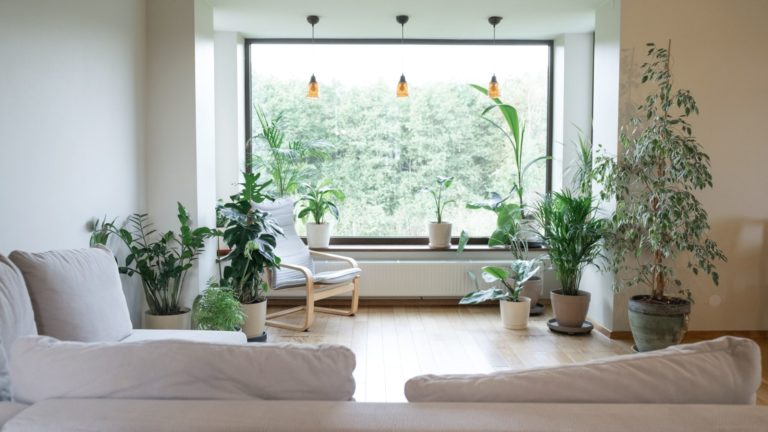In the hustle and bustle of modern life, moments of peace and tranquility can seem elusive. Yet, there lies an oasis of calm right under our noses: the world of indoor gardening. As people delve into the joys of tending to plants in the sanctity of their homes, they discover not just the beauty of foliage and flowers, but a myriad of therapeutic benefits that nurture their well-being.
A Symphony of the Senses
- A Feast for the Eyes: When you step into a room filled with lush green plants, vibrant blooms, and trailing ivies, it’s like entering a painting in motion. The array of colors, shapes, and textures serves as a visual treat. Studies have shown that merely gazing at nature, even through a window, can evoke feelings of relaxation and calm. When that natural beauty is just an arm’s length away, the sense of contentment amplifies manifold.
- Nature’s Perfume: Many indoor plants, such as jasmine, lavender, and gardenia, produce aromatic blooms. These natural fragrances act as gentle mood lifters. In the absence of artificial chemicals, these scents can be deeply grounding and help anchor one to the present moment.
- The Touch of Life: The tactile experience of gardening – feeling the soil, touching the leaves, or carefully pruning a stem – connects us directly to the life force of the planet. It’s a hands-on reminder of the interconnectedness of all life.
Personal Growth and Plant Growth
Gardening indoors isn’t just about plants growing; it mirrors personal growth.
- Nurturing Patience: In a world where instant gratification reigns supreme, watching a seed germinate or waiting for a bloom can be a gentle lesson in patience. It’s a reminder that good things come to those who wait.
- Embracing Impermanence: Plants have life cycles, just like all living beings. They sprout, grow, bloom, wither, and sometimes, despite our best efforts, they might not thrive. Indoor gardening offers a unique perspective on the transient nature of existence and the beauty that lies in every stage of life.
- Mindful Moments: Attending to plants requires keen observation and attention to detail. Over time, gardeners find themselves deeply engrossed in the moment, whether they’re watering, pruning, or simply admiring their green companions. Such acts of mindfulness can be incredibly grounding and provide a respite from the chaotic external world.

Creativity and Expression
Gardening is as much an art as it is a science. The canvas? Your living space. The paints? Plants of various kinds.
- Designing Your Sanctuary: Deciding where to place a fern, which pots complement a particular room, or how to create a mini jungle in a small space allows for creative expression. As individuals experiment with different setups and aesthetics, they not only beautify their space but also forge a personal connection with it.
- Storytelling Through Plants: Each plant carries a story – where it’s from, how it got to your home, and the journey you’ve shared with it. Sharing these stories with friends and family can be a source of joy and connection. Moreover, a collection of plants can serve as a reflection of one’s tastes, travels, and experiences.
A Portal to a Wider Community
Indoor gardening isn’t an isolated endeavor. It opens doors to a vast community of like-minded enthusiasts.
- Shared Learning: Whether it’s online forums, social media groups, or local gardening clubs, there are myriad platforms where individuals can share tips, discuss challenges, and celebrate successes. This shared journey can foster feelings of belonging and camaraderie.
- Eco-awareness and Responsibility: Engaging with plants daily can heighten one’s sensitivity towards broader environmental issues. Indoor gardeners often find themselves becoming more conscientious about sustainability and the well-being of the planet.
Embracing the Challenge and Triumph
- Overcoming Setbacks: Just like in life, indoor gardening comes with its set of challenges. From pests to incorrect watering, plants might face hurdles in their growth. Addressing these issues, researching solutions, and implementing changes can be deeply satisfying. Overcoming these challenges teaches resilience and adaptability, offering lessons that can be applied in other spheres of life.
- Celebrate Small Wins: Every new leaf or bloom becomes a cause for celebration. These small milestones in a plant’s life serve as tangible rewards for the care and dedication put in. They remind us of the beauty of small achievements and the importance of cherishing them.
Connecting to Heritage and Ancestry
- Roots and Heritage: Many people turn to indoor gardening to grow plants that have cultural or familial significance. Growing herbs used in traditional family recipes, for example, can be a tangible connection to one’s ancestry and heritage. These plants become more than just greenery; they represent stories, traditions, and memories.
- Passing Down Knowledge: The art of gardening often gets passed down generations. As parents and grandparents share their knowledge about plants and their care, it not only preserves traditional wisdom but also strengthens intergenerational bonds. Sharing gardening stories and experiences can be a deeply bonding activity, ensuring that the green legacy continues to flourish.
In essence, indoor gardening is not just a hobby; it’s a holistic experience that caters to our sensory, emotional, creative, and communal needs. As we water our plants, we water aspects of ourselves that often get neglected in the cacophony of daily life. In cultivating plants, we cultivate well-being, grounding ourselves in the simple yet profound joys of life.


